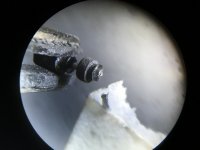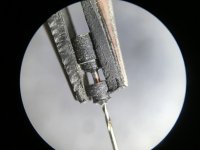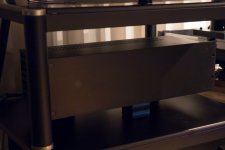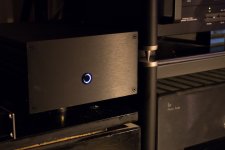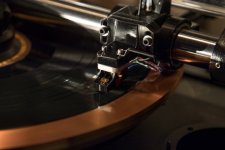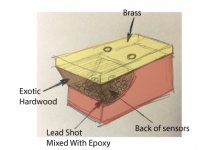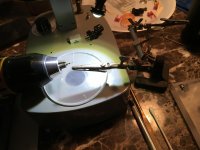Just a hot tip
I recently repaired a strain gauge pre-amp put together by one of the GB members.
It differed in only two key components from mine; the 820pF capacitor in the EQ was an RTE, and the output and supply capacitors were Audyn Plus 1.0uF.
Everything else was RTX.
This pre-amp is identical to the final version we all built, but I thought it was more coherent and detailed with a more neutral tonal balance than the original prototype with tube supplies, and slightly different from my prototype of the final version. I think I preferred it overall to both of mine.
The Audyn Plus 1.0uF is available from Parts Express and is extremely inexpensive at $8.90 each. It apparently betters a cap that cost almost 5X as much. It is a tight fit, but does fit.
I bought some as well as the Audyn Copper which is not inexpensive to experiment with. I'll report back.
Anyone on a budget or wanting to keep prices sane should consider the RTX/RTE/cheap Audyn cap combination.
I recently repaired a strain gauge pre-amp put together by one of the GB members.
It differed in only two key components from mine; the 820pF capacitor in the EQ was an RTE, and the output and supply capacitors were Audyn Plus 1.0uF.
Everything else was RTX.
This pre-amp is identical to the final version we all built, but I thought it was more coherent and detailed with a more neutral tonal balance than the original prototype with tube supplies, and slightly different from my prototype of the final version. I think I preferred it overall to both of mine.
The Audyn Plus 1.0uF is available from Parts Express and is extremely inexpensive at $8.90 each. It apparently betters a cap that cost almost 5X as much. It is a tight fit, but does fit.
I bought some as well as the Audyn Copper which is not inexpensive to experiment with. I'll report back.
Anyone on a budget or wanting to keep prices sane should consider the RTX/RTE/cheap Audyn cap combination.
I finally got the SG phono pre done. I had trouble to finish the phono due to my very limited electronic knowledge and experience. Kevin was kind enough to repair and finish it for me.
My reference LP playing back system consists of an Aesthetix Io phono. It is two pieces of phono with power supply in separate chassis. I love this piece of audio equipment and own it for more than 10 years now. It has almost unlimited dynamics and very high gain for almost any low output cartridges. The cartridges I have in hand are Ortofon A90, Benz LPs, Modified and re-tipped Denon DL-103R and Koetsu Rosewood Signature. So, the SG system has a formidable task to challenge my reference standard.
I started to set the VTF of Panasonic SG EPC-451C at 2.1 g and ended it with 2.8 g. The cartridge sits lower than I expected. Even VTF at 2 g, I had no trouble to tack the records. The gap between surface of record and the body of cartridge is about 1 and 1.5 mm. I used cantilever of SG cartridge as reference to set its VTA. The tip of the cantilever is parallel to record surface.
For the cartridge, I did a tweak on it as I posted it before. I used a thin piece of lead to insert into the U channel of stylus with some epoxy.
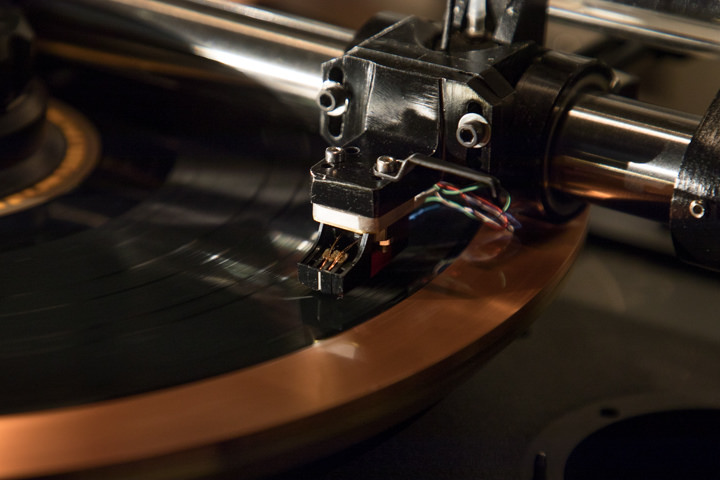
From the photo, you may see the cartridge is naked without the cover because I took it off to peek inside of cartridge but I misplaced the cover and I can’t find it now. So, the cartridge has to be running naked.
Once I turned the SG phono on, I noticed it is very quiet. It is quieter than my Aesthetix Io although I understand my Io phono may need some new tubes.
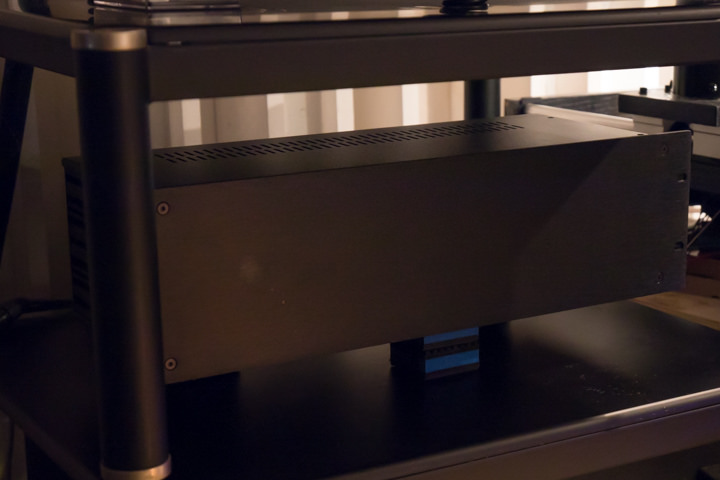

The SG system has very nice high frequencies, detailed not harsh at all. For some incorrect set up MC cartridges, you can heard mechanical sounding caused by stylus. The SG system faithfully renders string instruments. In my system, SG cartridge doesn’t sound “splash” as someone described here but my ears can detect there was a hint of “splash” sound around 1.5kHz to 2kHz. Further damping for the cartridge is probably needed.
The SG system performed well in low octave. In fact, I had to turn my pair of subs down a little to reduce bass information.
The SG system also has excellent sound stage. Its sound stage was total 360 degree dimensional. The depth and the size of sound stage were also correctly rendered. I enjoyed it very much when I was playing Verdi Aida, complete opera conducted by Karajan on London.
However, dynamics is not the last word for SG system.
Here is a thought which may help to increase dynamics.
As you may know, the SG cartridge has a rubber ring mounted in the middle of cantilever. The rubber ring vibrates following the vibration of cantilever to send information to the sensors. However, rubber has elasticity which may cause delay in transmission of vibrations. This may lead weak dynamics in sound. If I can replace the rubber ring with some kind of solid material, such as aluminum, it may improve dynamics because the rubber material may damp some of vibrations. But my thought may not work at all. It is just a thought.
The SG cartridge I am using is a NOS. It may need some time to break in. In the meantimes, its rubber ring may not function as well as it was new. I am going to continue to use the SG system and try to break it in as fast as I can.
I believe the performance of SG system has a lot to do with the cartridge. Since SG cartridges are made many years ago and it is not updated by current developments in technology. And, the sensors and the rubber ring may deteriorate over the time. However, it is still worth for its cost and performance. If you want go beyond the performance level of SG system, you need to pay two or three times more money for.
Kevin has done an excellent job! Thank you!
My reference LP playing back system consists of an Aesthetix Io phono. It is two pieces of phono with power supply in separate chassis. I love this piece of audio equipment and own it for more than 10 years now. It has almost unlimited dynamics and very high gain for almost any low output cartridges. The cartridges I have in hand are Ortofon A90, Benz LPs, Modified and re-tipped Denon DL-103R and Koetsu Rosewood Signature. So, the SG system has a formidable task to challenge my reference standard.
I started to set the VTF of Panasonic SG EPC-451C at 2.1 g and ended it with 2.8 g. The cartridge sits lower than I expected. Even VTF at 2 g, I had no trouble to tack the records. The gap between surface of record and the body of cartridge is about 1 and 1.5 mm. I used cantilever of SG cartridge as reference to set its VTA. The tip of the cantilever is parallel to record surface.
For the cartridge, I did a tweak on it as I posted it before. I used a thin piece of lead to insert into the U channel of stylus with some epoxy.
From the photo, you may see the cartridge is naked without the cover because I took it off to peek inside of cartridge but I misplaced the cover and I can’t find it now. So, the cartridge has to be running naked.
Once I turned the SG phono on, I noticed it is very quiet. It is quieter than my Aesthetix Io although I understand my Io phono may need some new tubes.
The SG system has very nice high frequencies, detailed not harsh at all. For some incorrect set up MC cartridges, you can heard mechanical sounding caused by stylus. The SG system faithfully renders string instruments. In my system, SG cartridge doesn’t sound “splash” as someone described here but my ears can detect there was a hint of “splash” sound around 1.5kHz to 2kHz. Further damping for the cartridge is probably needed.
The SG system performed well in low octave. In fact, I had to turn my pair of subs down a little to reduce bass information.
The SG system also has excellent sound stage. Its sound stage was total 360 degree dimensional. The depth and the size of sound stage were also correctly rendered. I enjoyed it very much when I was playing Verdi Aida, complete opera conducted by Karajan on London.
However, dynamics is not the last word for SG system.
Here is a thought which may help to increase dynamics.
As you may know, the SG cartridge has a rubber ring mounted in the middle of cantilever. The rubber ring vibrates following the vibration of cantilever to send information to the sensors. However, rubber has elasticity which may cause delay in transmission of vibrations. This may lead weak dynamics in sound. If I can replace the rubber ring with some kind of solid material, such as aluminum, it may improve dynamics because the rubber material may damp some of vibrations. But my thought may not work at all. It is just a thought.
The SG cartridge I am using is a NOS. It may need some time to break in. In the meantimes, its rubber ring may not function as well as it was new. I am going to continue to use the SG system and try to break it in as fast as I can.
I believe the performance of SG system has a lot to do with the cartridge. Since SG cartridges are made many years ago and it is not updated by current developments in technology. And, the sensors and the rubber ring may deteriorate over the time. However, it is still worth for its cost and performance. If you want go beyond the performance level of SG system, you need to pay two or three times more money for.
Kevin has done an excellent job! Thank you!
Attachments
Thank you for the detailed update! 
These cartridges do need some break in time, (whether NOS or used ones having sat unused for a long time).
The blue tack fix on the nose of the cartridge, ugly as it is, I think is mandatory; It takes care of some nasty resonances in the body of the cartridge, and greatly reduces cross-talk between the transducers. It should to a significant extent address the problem in the 1.5 - 2kHz region you mention. (I noticed the same and some echo as well - all body related)
These cartridges do need some break in time, (whether NOS or used ones having sat unused for a long time).
The blue tack fix on the nose of the cartridge, ugly as it is, I think is mandatory; It takes care of some nasty resonances in the body of the cartridge, and greatly reduces cross-talk between the transducers. It should to a significant extent address the problem in the 1.5 - 2kHz region you mention. (I noticed the same and some echo as well - all body related)
Kevin,
I will definitely try blue tack first for now. I am also thinking more permanent solution. After listening to SG system, it somewhat changes my mind. I thought the most important thing to do for SG cartridge is to change its cantilever. But now, I think it may be even more important to tweak the body because I feel the original stylus is doing pretty decent job. I didn’t feel I missed details too much comparing good MC cartridges. Peter at Sound Smith told me same thing.
It seems to me that we don’t have the option to re-make a complete new body so modifying the original body makes sense to me. This is what I am thinking now. Please see the image.
Fill the body with lead shots mixed with epoxy.
Glue a curved exotic hardwood to support back of sensors.
Use a piece fo 4 mm thick brass as base.
In the meantimes, I would like to add some weight to the SG cartridge. I want to make it 14-17 g.
Anyway, I am not going to do it now. I want to wait until the cartridge is fully broken in.
Jim
I will definitely try blue tack first for now. I am also thinking more permanent solution. After listening to SG system, it somewhat changes my mind. I thought the most important thing to do for SG cartridge is to change its cantilever. But now, I think it may be even more important to tweak the body because I feel the original stylus is doing pretty decent job. I didn’t feel I missed details too much comparing good MC cartridges. Peter at Sound Smith told me same thing.
It seems to me that we don’t have the option to re-make a complete new body so modifying the original body makes sense to me. This is what I am thinking now. Please see the image.
Fill the body with lead shots mixed with epoxy.
Glue a curved exotic hardwood to support back of sensors.
Use a piece fo 4 mm thick brass as base.
In the meantimes, I would like to add some weight to the SG cartridge. I want to make it 14-17 g.
Anyway, I am not going to do it now. I want to wait until the cartridge is fully broken in.
Jim
Attachments
Last edited:
I think deadening the body will help, Dave is currently experimenting with bodies and styli. I think it is important to note that nothing should come directly in contact with the transducers except the elastomeric damper and mount, and the coupler.
The transducers sit in a sort of cradle that is semi-floating (i.e. there is some slop in the mounting arrangement) which actually helps the stylus center correctly on the transducers. I tried applying blue tac in a couple of spots internally that resulted in a serious channel imbalance.
The transducers sit in a sort of cradle that is semi-floating (i.e. there is some slop in the mounting arrangement) which actually helps the stylus center correctly on the transducers. I tried applying blue tac in a couple of spots internally that resulted in a serious channel imbalance.
Sorry for the delay as personal attention was needed in other areas of concern.
Some pics of progress..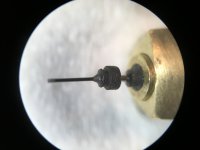
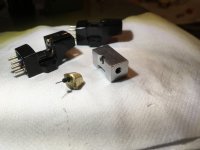
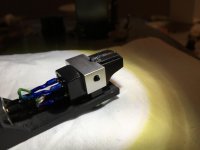
It took 2 hands braced against the counter top under a scope to insert the boron cantilever with tweezers dabbed in epoxy. All epoxy mating surfaces were cleaned with Acetone beforehand.
This happens to be a 450c2 modified body first to see how it sounds.
I will move this to a 451 since this is the best version I have listened too so far of the stock SG cartridges.
The middle pic shows a stock unmodified body near the top cluster
I can adjust left and right as well as in and out in relation to where I want the donut to press on the Strain elements. All for perfect alignment perimeters as well as stiffening the stock body by being clamped solid to the head shell.
Now to hear if it does anything positive over a stock version
Expectation bias needs to be put in proper perspective and will compare it with the other stock examples
Enjoy !
Regards
David
Some pics of progress..



It took 2 hands braced against the counter top under a scope to insert the boron cantilever with tweezers dabbed in epoxy. All epoxy mating surfaces were cleaned with Acetone beforehand.
This happens to be a 450c2 modified body first to see how it sounds.
I will move this to a 451 since this is the best version I have listened too so far of the stock SG cartridges.
The middle pic shows a stock unmodified body near the top cluster
I can adjust left and right as well as in and out in relation to where I want the donut to press on the Strain elements. All for perfect alignment perimeters as well as stiffening the stock body by being clamped solid to the head shell.
Now to hear if it does anything positive over a stock version
Expectation bias needs to be put in proper perspective and will compare it with the other stock examples
Enjoy !
Regards
David
I was able to spin and look at the centering before bracing the boron rod while it dried. I use 4 hour setup time epoxy instead of the typical 5 minute brands available
I tested 5 brands for hardness ( 3 week cure time ) by poking them under a scope and noticed this was the hardest despite what all their specs said
I did mix in some diamond dust in all tests examples as well as without.
I did add it in with this cantilever.
I can remove and cut away and start over while saving the boron if I want so all is not lost if something goes wrong.
Regards
David
I tested 5 brands for hardness ( 3 week cure time ) by poking them under a scope and noticed this was the hardest despite what all their specs said
I did mix in some diamond dust in all tests examples as well as without.
I did add it in with this cantilever.
I can remove and cut away and start over while saving the boron if I want so all is not lost if something goes wrong.
Regards
David
Attachments
Hello , Dave
First I wanted the ability to adjust all perimeters where the donut presses in on the strain beams left ,right, in and out or where the donut actually presses on the strips.
To be able to do that, it required the brass housing which took up the stock body real estate and hence the cutout depth.
Out of 4 SG cartridges only 1 had perfect centering and I wanted perfect alignment
The brass flat section rests on that cutout actually and sets the proper location for the cantilever/donut angle.
The side set screws allow left right orientation and crab the brass housing from both sides and lock it tight.
There is another set screw on the bottom that locks the brass cylinder that holds the stock cantilever pivot point.
I was careful to not allow a tight fit and the hole was about .020” of clearance bigger all around the foam pivot and used 100% pure silicone to hold it stable.
I used 6061 T6 aluminum for the removable section and made a tight press fit right up to the edge of the SG strips and the added benefit the whole enclilada clamps the remaining plastic body very rigid or more so than a stock version could ever accomplish on its own.
No slop front and back and requires a firm press fit before screwing to headshell.
I,m not sure if I will remake a completely new body that holds the SG elements because you can deaden it quite effectively and when you consider how soft the SG strips are captured, just what will occur with a billet main body ? It will still need the same rubber enclosure material. I am fairly certain it is an essential component to its sound signature and SG damping properties.
However , I am beginning to think that maybe slicing the soft rubber 2 strip capture material right down to the body and inserting a wood veneer parallel between them might allow better cross talk figures.
Seems like a logical easy mod anyone could accomplish with a razor blade and a little imagination!
What is happening in the left channel might not transfer thru the material and affect the other side as easily if a barrier is placed between them ?
The flat horizontal section allows a better view of azimuth when looking from the front while aligning
This is a 450c2 and I will cut down a 451 next since these are the best versions IMHO.
The 450 c2 has a little to much gain
I have only had a chance to listen for a couple of hours without comparisons and can tell you everything improves across the board, but need more time to narrow down exact differences and eliminate the expectation bias bliss stage..,.
Regards
David
First I wanted the ability to adjust all perimeters where the donut presses in on the strain beams left ,right, in and out or where the donut actually presses on the strips.
To be able to do that, it required the brass housing which took up the stock body real estate and hence the cutout depth.
Out of 4 SG cartridges only 1 had perfect centering and I wanted perfect alignment
The brass flat section rests on that cutout actually and sets the proper location for the cantilever/donut angle.
The side set screws allow left right orientation and crab the brass housing from both sides and lock it tight.
There is another set screw on the bottom that locks the brass cylinder that holds the stock cantilever pivot point.
I was careful to not allow a tight fit and the hole was about .020” of clearance bigger all around the foam pivot and used 100% pure silicone to hold it stable.
I used 6061 T6 aluminum for the removable section and made a tight press fit right up to the edge of the SG strips and the added benefit the whole enclilada clamps the remaining plastic body very rigid or more so than a stock version could ever accomplish on its own.
No slop front and back and requires a firm press fit before screwing to headshell.
I,m not sure if I will remake a completely new body that holds the SG elements because you can deaden it quite effectively and when you consider how soft the SG strips are captured, just what will occur with a billet main body ? It will still need the same rubber enclosure material. I am fairly certain it is an essential component to its sound signature and SG damping properties.
However , I am beginning to think that maybe slicing the soft rubber 2 strip capture material right down to the body and inserting a wood veneer parallel between them might allow better cross talk figures.
Seems like a logical easy mod anyone could accomplish with a razor blade and a little imagination!
What is happening in the left channel might not transfer thru the material and affect the other side as easily if a barrier is placed between them ?
The flat horizontal section allows a better view of azimuth when looking from the front while aligning
This is a 450c2 and I will cut down a 451 next since these are the best versions IMHO.
The 450 c2 has a little to much gain
I have only had a chance to listen for a couple of hours without comparisons and can tell you everything improves across the board, but need more time to narrow down exact differences and eliminate the expectation bias bliss stage..,.
Regards
David
Last edited:
Dave, it sounds like you've made some pretty significant progress of late.
I recently acquired a stylus from Dave Slagle (he's a friend), initial setup and listening tests are promising. Some break in time is required interestingly enough.
I'll not be able to do any long term listening and tweaking until it cools down here. It is so hot here in Boston at the moment that the additional heat load from the amps results in intolerable temperatures here in the man cave in about an hour of listening. Six channels of SE DHT power amplification plus the ancillary electronics results in close to 900W of dissipation during listening. Welcome for the 8 months of the year here when it's not particularly warm, but oh so not welcome now. The AC down here cannot keep up and is noisy as all get out.
The system has changed massively over the past few months which provided the opportunity to add 4 new channels of amplification and electronic crossovers. I had the time to design and build all of this stuff as I was between jobs. I have a new & demanding position with a consumer electronics company so time is at a premium as well now.
All of this means I have lots of work to do ahead of me to get the system just "right."
I recently acquired a stylus from Dave Slagle (he's a friend), initial setup and listening tests are promising. Some break in time is required interestingly enough.
I'll not be able to do any long term listening and tweaking until it cools down here. It is so hot here in Boston at the moment that the additional heat load from the amps results in intolerable temperatures here in the man cave in about an hour of listening. Six channels of SE DHT power amplification plus the ancillary electronics results in close to 900W of dissipation during listening. Welcome for the 8 months of the year here when it's not particularly warm, but oh so not welcome now. The AC down here cannot keep up and is noisy as all get out.
The system has changed massively over the past few months which provided the opportunity to add 4 new channels of amplification and electronic crossovers. I had the time to design and build all of this stuff as I was between jobs. I have a new & demanding position with a consumer electronics company so time is at a premium as well now.
All of this means I have lots of work to do ahead of me to get the system just "right."
Kevin I hear you !
Heat and critical listening is impossible !
Winter time listening is the time I spend a lot of hours with the sound sytem.
The colder the better in your listening arena
Most people equate late late listening pleasure to clean power lines at night, but in reality and a talk with Richard Vandersteen at the bar in our recent Irvine Hiend event, he mentioned it’s not the so called cleaner AC power at night (still a mess ) but better signal to noise ratio with the outside world asleep and quiet leading to a more focused attention span
With AC blowing to keep things cool, your listening attention span is severely reduced due to the added “wind”
I hope your rebuild allowed the removable nature of the stock version to place it parallel and not cocked at an angle like 3 of my cartridges always did regardless.
Regards
David
Heat and critical listening is impossible !
Winter time listening is the time I spend a lot of hours with the sound sytem.
The colder the better in your listening arena
Most people equate late late listening pleasure to clean power lines at night, but in reality and a talk with Richard Vandersteen at the bar in our recent Irvine Hiend event, he mentioned it’s not the so called cleaner AC power at night (still a mess ) but better signal to noise ratio with the outside world asleep and quiet leading to a more focused attention span
With AC blowing to keep things cool, your listening attention span is severely reduced due to the added “wind”
I hope your rebuild allowed the removable nature of the stock version to place it parallel and not cocked at an angle like 3 of my cartridges always did regardless.
Regards
David
I'm blessed to live in a generally very quiet neighborhood, the noise levels in this room average 20dBA or less. My only problem is a couple of power transformers that are a bit noisier than this.
Power quality is terrible here, I use regulated supplies and heavily filter those that are not, so for the most part I am not badly affected. It is noticeable though during the day with sound quality deteriorating very noticeably in the late afternoon and early evening as people start getting home and the load on the local infrastructure increases. (Very new and modern around here actually, and the transformers on the poles are all dinky)
Power quality is terrible here, I use regulated supplies and heavily filter those that are not, so for the most part I am not badly affected. It is noticeable though during the day with sound quality deteriorating very noticeably in the late afternoon and early evening as people start getting home and the load on the local infrastructure increases. (Very new and modern around here actually, and the transformers on the poles are all dinky)
<snip>
I hope your rebuild allowed the removable nature of the stock version to place it parallel and not cocked at an angle like 3 of my cartridges always did regardless.
Regards
David
Completely stock configuration, and as long as the cradle the transducers are mounted to semi floats it seems to align OK.
One of the possible benefits of the boron cantilever and MR stylus is a longer service life. I am not getting great service out of the OEM Shibata, about 300 hours is it, so the MR might give twice that.

This is Dynavectors micro-ridge photo of the Namiki profile and you can see as it wears it maintains its tracing width tracking.
However, when it gets down to its limit it will start causing record wear.
I strongly suggest using Last Sytlast on the tip every Side played.
I use a small round stylus cleaning brush and brush from back to front in one direction and apply the Stylast with a dab of it
We have a solid boron rod and no mitigation will occur that might with those hollow versions
Haven’t tried their other products, but have used this stuff for over 30 yrs and feel it does help reduce tip wear.
There are plenty of Research info and electron microscope photos for proof it’s not snake oil.
Regards
David
Nice thread! I also own a NOS Panasonic EPC-450CII cartridge! Its true that the VTA plays a very important role here but EQ isnt! This cart performs best in a minimalist way no EQ is needed and no added "ballast"! My SG amplifier is a very simple reactor loaded common gain stage of 38dB gain! Thats all! It sounds amazing transparent! I dont think that in this particular case the main goal should be to bring the SG to an near ideal RIAA line! If we need to EQ a system then why to bother with SG, buy a MM or MC and a phono stage and you are done! The human ear isnt linear at all! It would be interesting to make lines of our ear instruments. What results that would bring out? 
Last edited by a moderator:
Then a permanent tone control is what satisfies you.
If one purchased an expensive MM or MC and had the same wild swings as a stock SG, how would the market respond ?
Why should the SG bypass this reasonable requirement ?
Why stop there, might as well have preamps, amplifiers, speakers, all have wildly uneven frequency responses ?
Can you see at least some standard such as flat frequency reponse as a foundation to build on like everything else in the audio chain ?
Regards
David
If one purchased an expensive MM or MC and had the same wild swings as a stock SG, how would the market respond ?
Why should the SG bypass this reasonable requirement ?
Why stop there, might as well have preamps, amplifiers, speakers, all have wildly uneven frequency responses ?
Can you see at least some standard such as flat frequency reponse as a foundation to build on like everything else in the audio chain ?
Regards
David
Nice thread! I also own a NOS Panasonic EPC-450CII cartridge! Its true that the VTA plays a very important role here but EQ isnt! This cart performs best in a minimalist way no EQ is needed and no added "ballast"! My SG amplifier is a very simple reactor loaded common gain stage of 38dB gain! Thats all! It sounds amazing transparent! I dont think that in this particular case the main goal should be to bring the SG to an near ideal RIAA line! If we need to EQ a system then why to bother with SG, buy a MM or MC and a phono stage and you are done! The human ear isnt linear at all! It would be interesting to make lines of our ear instruments. What results that would bring out?
I can't say I agree with much of anything you've stated in your post. It's quite easy to determine the relative merits of two devices intended for the same purpose through comparative listening and measurements.
You are of course entitled to your opinion and to even post a dissenting viewpoint.
While I am somewhat swayed by subjective considerations since foolishly I still play [with] vinyl (admittedly the stupidest existing and most irrational format for music reproduction that is still extant) I am a rational designer who believes that measurements while they don't necessarily tell the whole story are useful to help get to the truth.
I do wonder how much of the thread you actually bothered to read before airing your viewpoint here. Had you read it you would have perhaps realized that quite a lot of experimentation, measurement, and even listening went into the design of the pre-amp discussed here.
As a point of reference I have owned several relatively high end LOMC cartridges and still own an Ortofon Windfeld and an Ortofon SPU A95.
I thought the SG had some interesting performance benefits over conventional MC cartridges including better sound stage presentation, low level detail, and imaging, but the tonal balance was very wrong and to me intolerable for more than a few minutes.
I started with an unequalized pre-amplifier, listened and did some frequency response measurements and basically confirmed the measurements published in hifi magazines decades ago. It also drove me to the logical conclusion that without help this is not a good sounding cartridge in a lot of ways.
My goal was simply to bring the performance up to the level of a decent if not spectacular MC, I think I have succeeded to some extent.
It's unfortunate that it was not developed further and that the cartridge was aimed at the rock bottom of the market; cheap Quad systems and crummy compact stereo systems, and it shows. It has obvious shortcomings as do most transducers.
This is a largely an engineering driven discussion - it's what I do for a living, and it is what my belief system is built around.
I simply wanted to see what I could do with the cartridge, and try to determine what one would sound like if the grossest response aberrations were substantially, bringing the frequency response at least close to what the RIAA standard requires.
As a frame of reference my speaker system is flat to +/- a couple of dB over a range of 200Hz - 20kHz when everything is working correctly. The speaker system is a 3 way diy Onken bass bin on the bottom with JBL horns on mids (2440/2382A) and Fostex T825 on top. Resolution is pretty good, and it's not very forgiving of FR anomalies.
The system is tri-amplified with six channels of power amplification comprising tubes, mosfets and amorphous core transformers. The electronic crossovers (LR4), line stage and phono pre-amplifiers are all of my own design. Sources are TD-124 with ET2/ET2.5 air bearing tonearms and a couple of these strain gauge cartridges. I have digital sources too which are much less trouble, but don't always sound great (but more consistent by far than analog). And it's a work in progress.
My vision of what a good system comprises and sounds like clearly is not yours.
- Home
- Source & Line
- Analogue Source
- Playing With Panasonic Strain Gauge Cartridges (And A Dedicated Phono Stage)
